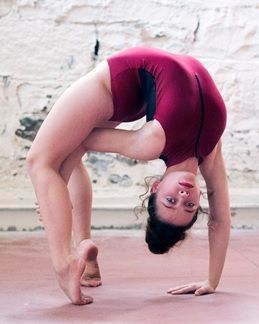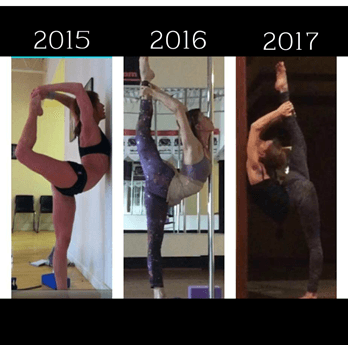How do contortionists get so flexible? It’s a question that fascinates many. Achieving extreme flexibility requires a combination of natural hypermobility, proper training, and consistent stretching routines. In this article, we’ll answer common questions about contortion and explore the science behind these remarkable feats.
“How do they bend like that?” Contortion and Hypermobility Questions Answered
The questions I am asked most as a flexibility specialist/ contortion trainer are:
- “How do they bend like that?”
- “Is she double-jointed?”
- “Does she have a spine?”
Especially after they see this:

Shelby Miller @twisted_shelby Photo by: Brent Clark @brentclark20965
Understanding Contortion and Hypermobility: Double-Jointedness
If you’ve ever asked yourself ‘how do contortionists get so flexible,’ the answer lies in a combination of genetic predisposition, proper technique, and consistent training. And while hypermobility is frequently referred to as being double-jointed, technically that does not mean two joints allow these flexible positions to happen. It is possible to have extra bones but the real reason behind the flexibility is an increased range of motion. Sometimes this is a condition you are born with, Joint Hypermobility Syndrome (joints are unstable) or a condition called Ehlers-Danlos syndrome (EDS). Unstable joints can cause sprains, tendinitis, or bursitis. Hypermobility can be created however EDS cannot.
How Starting Young Helps Contortionists Get So Flexible
Yes. When we are younger we have more collagen fibers & less calcium in our muscles and joints. This allows the body to move more freely. As we age we have less collagen and more calcium hardening the muscles & joints so becoming more flexible can be a slower process, but not impossible.
Age is Just a Number: Breaking Stereotypes in Contortion
If you research it, the books will tell you not to start after the age of 26 however I have a Skype client that proved that theory wrong.
Meet Lisa. Lisa is a skilled pole dancer. She decided to break into the art of contortion at the young age of 47. She asked me if it was too late. I said, “There are no limits”. And boy did she prove that theory wrong.

Exploring the Flexibility of the Spine
Your spine is made up of 3 sections. The lumbar/lower back (made up of 5 vertebrae), Thoracic/mid-back (12 vertebrae) and the Cervical/Neck (7 vertebrae). In between each vertebra is a disc. Each disc supports a vertebra and acts as a cushion, a shock absorber. Important to remember how vital water consumption is to keep this cushion hydrated.
Stretching and Strengthening: How Contortionists Get So Flexible
The secret to answering ‘How do contortionists get so flexible’ is to balance strength and flexibility through targeted stretching and strengthening exercises. The muscles that run along the spine hold the vertebra in place and this is why strengthening the back muscles is super important. So lengthening the muscles along the spine and with the support of the discs, extreme flexibility is possible in the back.
“Stretch what you strengthen and strengthen what you stretch”, the golden rule for contortionists.
Strengthening increases muscle tone and shortens the muscles so stretching after strengthening is highly recommended to any athlete. This shortening you see sometimes in bodybuilders when they are unable to have their arms straight down. Why can this be harmful? If you happen to go into a flexible move with shortened muscles I’m sure you can figure out what could happen. Muscles could get torn and strained. The reciprocal of this is if all you did were to stretch, you would have no muscles to protect joints.
Stretch Duration: Key to How Contortionists Get So Flexible
At least 15-30 seconds to lengthen a muscle. When you are doing stretches it means that the cells in your muscle get longer and skinnier. If you are not holding this, chances are not much will happen. I have also noticed over the years that some stretch and unknowingly squeeze their muscles. How can you lengthen something your squeezing? Make perfect sense, you can’t.
Seek Qualified Trainers for Contortion Training
What I will continue to preach is if you are interested in learning the art of contortion do search out qualified trainers. We are educated on the importance of appropriate stretching and strengthening practices. There is a lot more to it than just mimicking a picture of the Internet. Proper stretching and strengthening practices, tailored to your individual needs, are essential for maintaining joint health and preventing injuries. Take care of your spine and neck by following expert advice and never underestimate the importance of proper training and technique. When it comes to your spine and neck, you can never be more careful.
Fact recourse; Gary Shuttleworth PT,CEAS, Director of Physical Therapy








Good day! Do you use Twitter? I’d like to follow you if that would be
ok. I’m undoubtedly enjoying your blog and look forward to new updates.
Hello! Thank you for your interest in staying updated with us on Twitter. We do have a Twitter account, and you can find us at @verticalwise. We’re thrilled to hear that you’re enjoying our blog, and we look forward to connecting with you on Twitter for the latest updates and insights. Feel free to follow us, and if you have any questions or thoughts to share, don’t hesitate to reach out. Have a great day!